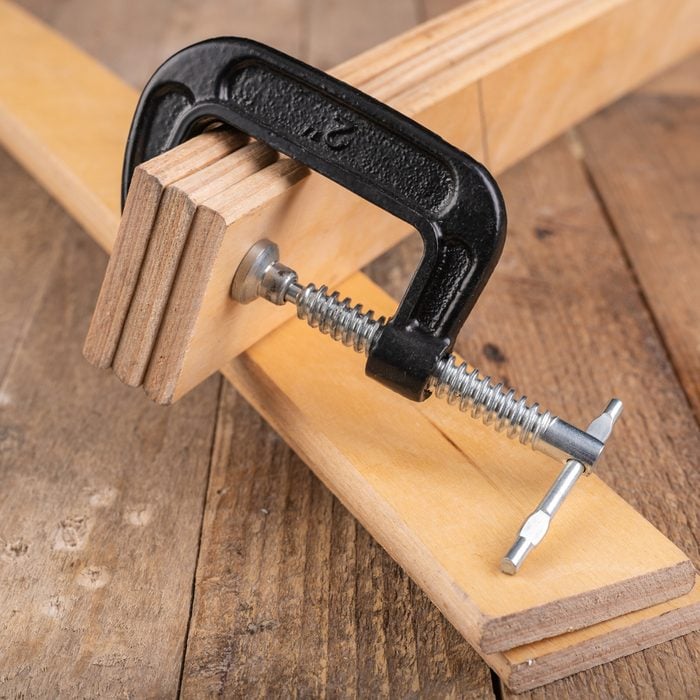9 Types of Clamps and What They’re Used For

You need clamps to hold something temporarily or permanently in place. Here are some of the most useful kinds of clamps.
All clamps serve the same purpose: to hold things securely. But you might be surprised at how many different varieties of clamps there are.
Every woodworking shop stocks several types of clamps so wood can be drilled, shaped and fastened together. They’re used by plumbers and electricians to secure pipes and conduit, fence companies use them to attach wire fencing to posts and rails, and metalworkers to weld. Some types of clamps are even useful in unintended ways.
I like to save money by changing the brake pads on my car, and no tool works better for pushing the piston back into the caliper than a C-clamp from my woodworking tool collection. When the handle on my neighbor’s faucet broke, he replaced it by tightening a small C-clamp on the valve stem. It worked so well that it’s still there.
Depending on where you look, you can find 30 to 40 types of clamps, and that probably still isn’t all of them. Some have specific uses, like miter clamps, which hold miter joints together until the glue sets. Many have multiple uses, and these are the ones most worth knowing about.
In many cases, you can avoid purchasing a specialty clamp by adapting a clamp you already have to the project at hand.
On This Page
Screw Clamps
One of the most effective clamping strategies is advancing a moveable jaw toward a stationary one by turning a threaded rod. Each turn advances the jaw a small amount, meaning you can generate a lot of force on an object between the jaws with little effort. And thanks to the threads, the rod can’t back off on its own.
A number of the most common clamps are screw clamps, including the following five types:
C-clamp
Shaped like the letter “C,” these come in all sizes. The spacing between the fully open jaws (i.e. jaw capacity) varies from less than an inch to 10 inches. The moveable jaw is on a threaded rod. A sliding cross pin on the end provides the leverage you need for turning.
There are multiple ways to use C-clamps, including:
- Holding pieces of wood together for gluing or fastening;
- Securing wooden objects to a workbench for cutting or shaping;
- Holding metal together for welding.
Bench clamp
Also known as a vise, a bench clamp is permanently attached to a workbench. They’re made from heavy-duty metal with wide jaws. You use a bench clamp to hold metal or wood in place so you can drill, cut or shape it.
Bar clamp
If you need a wider jaw capacity than a C-clamp, you reach for a bar clamp, aka a sash clamp. One jaw is attached to a threaded rod that passes through a plate at the end of a metal bar, while the other jaw slides along the bar and locks in place.
Woodworkers use bar clamps for laminating pieces of wood, to hold frames together for gluing or fastening, and to make sash windows, among other things.
Quick-release clamp
A quick-release clamp, aka a speed clamp, features a trigger on the fixed jaw. When you press the trigger, the jaw unlocks from the bar, releasing the pressure on the object you’re clamping.
Quick-release clamps usually aren’t as long as bar clamps and come with padded jaws. They’re perfect for holding together pieces of wood while you shape or fasten them.
Hand screw clamp
Strictly a woodworking tool, this features two wooden jaws and two metal screw rods placed side-by-side with handles at opposite ends. The wooden jaws don’t leave imprints on wood, and two rods provide more control for aligning the jaws than just one. Cabinetmakers use these extensively for assembling quality woodwork projects.
Spring Clamps
When you need to hold two pieces of material together during assembly, a spring clamp is an alternative to a screw clamp.
Spring clamps have a scissors-like action. The padded jaws open when you squeeze the two handles together, and an embedded spring clamps the jaws shut when you release the handles. They aren’t as strong as screw clamps, but they’re faster and easier to use.
Strap Clamps
Also known as a web clamp, a strap clamp consists of a strong nylon strap with a ratcheting mechanism affixed to one end. You wrap the strap around the object you’re fastening, feed the free end through the ratchet and pump the ratchet to tighten the strap.
In the wood shop, these are perfect for securing large frames while the glue joints set. Versions of these also commonly secure objects in truck beds.
Bench Clamps
A bench clamp features a base permanently attached to a workbench and a single padded jaw operated by a squeeze handle. You set the workpiece under the jaw and squeeze the handle repeatedly to ratchet the jaw down and hold the piece in place. Woodworkers use bench clamps to hold wood for sanding and shaping.
Hose Clamps
Plumbers and auto mechanics are some of the tradespeople who need to secure flexible hoses to metal or plastic pipes with metal bands.
The most common hose clamps feature a perforated metal band held in a circular shape by a nut. A screw threaded through the nut uses the perforations in the band as a worm drive to open and close the clamp when you turn the screw.
Double-eared spring clamps are also common. Squeezing the ears widens a circular metal ring, allowing the clamp to slide along the hose. When you release the ears, the ring tightens down onto the hose to hold it in place.




